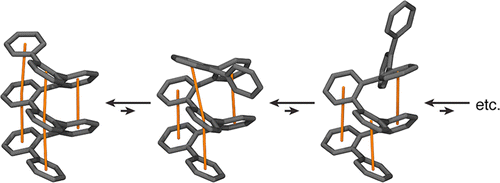Sanyo M. Mathew, James T. Engle, Christopher J. Ziegler, and C. Scott Hartley*
J. Am. Chem. Soc. 2013, 135, 6714–6722
[Published version]

Abstract
The ortho-phenylenes are a simple class of helical oligomers and representative of the broader class of sterically congested polyphenylenes. Recent work has shown that o-phenylenes fold into well-defined helical conformations (in solution and, typically, in the solid state); however, the specific causes of this folding behavior have not been determined. Here, we report the effect of substituents on the conformational distributions of a series of o-phenylene hexamers. These experiments are complemented by dispersion-corrected DFT calculations on model oligomers (B97-D/TZV(2d,2p)). The results are consistent with a deterministic role for offset arene–arene stacking interactions on the folding behavior. On the basis of the experimental and computational results, we propose a model for o-phenylene folding with two simple rules. (1) Conformers are forbidden if they include a particular sequence of biaryl torsional states that causes excessive steric strain. These “ABA” states correspond to consecutive dihedral angles of −55°/+130°/–55° (or +55°/–130°/+55). (2) The stability of the remaining conformers is determined by offset arene–arene stacking interactions that are easily estimated as an additive function of the number of well-folded torsional states (±55°) along the backbone. For the parent, unsubstituted poly(o-phenylene), each interaction contributes roughly 0.5 kcal/mol to the helix stability (in chloroform), although their strength is sensitive to substituent effects. The behavior of the o-phenylenes as a class is discussed in the context of this model. They are analogous to α-helices, with axial aromatic stacking interactions in place of hydrogen bonding. The model predicts that the overall folding propensity should be quite sensitive to relatively small changes in the strength of the arene–arene stacking. In a broader sense, these results demonstrate that polyphenylenes may exhibit folding behavior that is amenable to simple models, and validate the use of diffusion-corrected DFT methods in predicting their three-dimensional structures.
